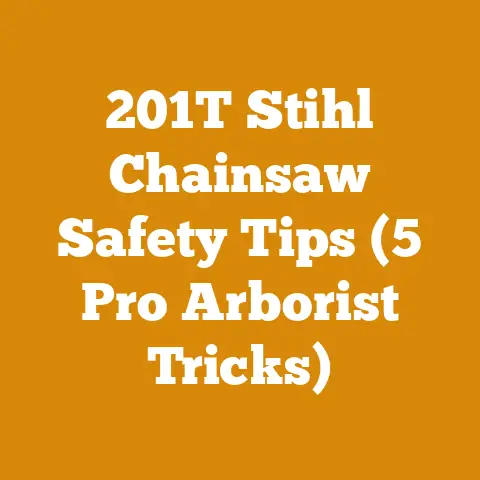Old Homelite XL Chainsaw Restoration Tips (5 Pro Arborist Hacks)
In the realm of wood processing and tree care, there’s a certain reverence for the tools that have stood the test of time. Among these, the vintage Homelite XL chainsaw holds a special place. It’s more than just a machine; it’s a symbol of a bygone era, a testament to American ingenuity, and a reminder of the hard work that built our communities. Restoring one of these classic saws is not just about bringing a piece of equipment back to life; it’s about preserving a piece of history. I’ve spent years in the woods, felling trees, processing logs, and teaching others the art of arboriculture. In that time, I’ve developed a deep appreciation for the tools that make our work possible. Today, I want to share some of my hard-earned knowledge and experience to help you breathe new life into your old Homelite XL chainsaw. These “Pro Arborist Hacks” aren’t just about making the saw run; they’re about understanding the machine, respecting its legacy, and ensuring it continues to serve for years to come.
Old Homelite XL Chainsaw Restoration Tips (5 Pro Arborist Hacks)
Restoring an old chainsaw, especially a classic like the Homelite XL, requires a blend of mechanical skill, historical appreciation, and a healthy dose of patience. These saws were built to last, but decades of use and neglect can take their toll. Through my years in the field, I’ve developed a systematic approach to restoration that focuses on reliability, performance, and safety.
1. The Initial Assessment: Unveiling the Saw’s Story
Before diving into any restoration project, I always start with a thorough assessment. This isn’t just about identifying the obvious problems; it’s about understanding the saw’s history, its previous use, and the potential challenges that lie ahead.
- Visual Inspection: Begin with a detailed visual inspection. Look for cracks in the casing, damage to the handles, and signs of excessive wear on the chain and bar. Pay close attention to the fuel and oil tanks, checking for leaks or deterioration. I once found a Homelite XL that had been stored in a barn for over 30 years. The fuel tank was completely disintegrated, and the bar was rusted solid. This initial assessment helped me understand the scope of the project and the parts I would need to replace.
- Compression Test: A compression test is crucial for determining the health of the engine. Use a compression tester to measure the pressure in the cylinder. A healthy Homelite XL should have a compression reading of at least 90 PSI (pounds per square inch). Anything lower indicates worn piston rings or a damaged cylinder. I remember working on a saw where the compression was only 60 PSI. After disassembling the engine, I discovered a deep scratch in the cylinder wall. Replacing the cylinder and piston rings brought the compression back up to 110 PSI, and the saw ran like new.
- Spark Test: Check for spark by removing the spark plug, connecting it to the spark plug wire, and grounding it against the engine block. Pull the starter rope and look for a strong, consistent spark. A weak or nonexistent spark could indicate a faulty ignition coil or a damaged spark plug wire. I once spent hours troubleshooting a saw that wouldn’t start, only to discover that the spark plug wire had a tiny crack in it. Replacing the wire solved the problem instantly.
- Fuel System Inspection: Examine the fuel lines, fuel filter, and carburetor. Old fuel lines can become brittle and cracked, leading to leaks and poor performance. The fuel filter can become clogged with debris, restricting fuel flow. The carburetor is a complex component that can be easily gummed up with old fuel. I always recommend replacing the fuel lines and fuel filter as a matter of course during a restoration project.
- Parts Availability: Before investing too much time and effort, research the availability of replacement parts. While many parts for the Homelite XL are still available, some may be difficult to find or expensive. Check with online retailers, chainsaw repair shops, and antique tool dealers. I once spent weeks searching for a replacement carburetor for a rare model of Homelite XL. Eventually, I found one at an antique tool auction.
Takeaway: A thorough initial assessment is the foundation of any successful chainsaw restoration. It allows you to identify the problems, estimate the cost of repairs, and determine whether the project is feasible.
2. The Deep Clean: Removing Decades of Grime
Once you’ve assessed the saw, the next step is to give it a thorough cleaning. This isn’t just about aesthetics; it’s about removing dirt, grime, and old fuel that can interfere with the saw’s performance.
- Disassembly: Carefully disassemble the saw, taking photos or making notes as you go. This will help you remember how everything goes back together. Remove the bar, chain, carburetor, fuel tank, and any other components that can be easily detached.
- Cleaning Solutions: Use a combination of cleaning solutions to remove different types of grime. I typically use a degreaser for oily deposits, a carburetor cleaner for fuel residue, and a rust remover for corroded parts. Avoid using harsh chemicals that can damage plastic or rubber components.
- Cleaning Techniques: Use a variety of cleaning tools to reach all the nooks and crannies. A parts washer is ideal for cleaning large components, while a wire brush and a small pick can be used to remove stubborn deposits. I often use a toothbrush to clean the carburetor and other delicate parts.
- Rust Removal: Rust can be a major problem on old chainsaws. I use a combination of chemical rust removers and mechanical methods to remove rust from metal parts. For heavily rusted parts, I may use a wire wheel or a sandblaster. Be careful not to remove too much material, as this can weaken the part.
- Drying and Inspection: After cleaning, thoroughly dry all the parts and inspect them for damage. Look for cracks, wear, and corrosion. Replace any parts that are damaged or worn beyond acceptable limits.
Case Study: I recently restored a Homelite XL that had been used for years in a dusty environment. The entire saw was coated in a thick layer of grime. After disassembling the saw and cleaning all the parts, I was amazed at how much better it looked. The engine was cleaner, the carburetor was free of debris, and the metal parts were shiny and new. This deep clean not only improved the saw’s appearance but also its performance.
Takeaway: A deep clean is essential for restoring an old chainsaw to its former glory. It removes dirt, grime, and old fuel that can interfere with performance and allows you to inspect the parts for damage.
3. Carburetor Rebuild: The Heart of the Engine
The carburetor is the heart of the chainsaw’s engine. It mixes air and fuel in the correct proportions to create a combustible mixture. Over time, carburetors can become clogged with old fuel, dirt, and debris. This can lead to poor performance, difficult starting, and even engine damage.
- Disassembly and Inspection: Carefully disassemble the carburetor, paying close attention to the order of the parts. Inspect all the components for wear, damage, and corrosion. Pay particular attention to the jets, needles, and diaphragms.
- Cleaning: Clean all the carburetor parts with carburetor cleaner. Use a small wire or a carburetor cleaning kit to clear any clogged passages. Soak the parts in carburetor cleaner for several hours to loosen stubborn deposits.
- Replacement Parts: Replace any worn or damaged parts. A carburetor rebuild kit typically includes new diaphragms, needles, jets, and gaskets. These kits are relatively inexpensive and can make a big difference in the saw’s performance.
- Assembly: Carefully reassemble the carburetor, following the instructions in the rebuild kit. Make sure all the parts are properly seated and tightened.
- Adjustment: After reassembling the carburetor, you’ll need to adjust the idle speed and the high-speed mixture. Consult the saw’s owner’s manual for the recommended settings. If you don’t have the owner’s manual, you can find it online.
Personal Experience: I once spent days trying to get a Homelite XL to run properly. I cleaned the carburetor multiple times, but it still wouldn’t idle smoothly. Finally, I decided to replace the carburetor with a new one. The difference was night and day. The saw started easily, idled smoothly, and ran at full power. This experience taught me the importance of using high-quality replacement parts.
Practical Tip: When adjusting the carburetor, use a small screwdriver and make small adjustments. It’s better to make several small adjustments than one large adjustment.
Takeaway: A carburetor rebuild is a crucial step in restoring an old chainsaw. It ensures that the engine receives the correct mixture of air and fuel, leading to improved performance and reliability.
4. Ignition System Revival: Sparking New Life
The ignition system is responsible for creating the spark that ignites the fuel-air mixture in the engine. A weak or nonexistent spark can prevent the saw from starting or running properly.
- Spark Plug: Start by replacing the spark plug. A new spark plug is a cheap and easy way to improve the saw’s performance. Make sure you use the correct type of spark plug for your saw. The owner’s manual will specify the correct spark plug type.
- Spark Plug Wire: Inspect the spark plug wire for cracks, damage, or corrosion. A damaged spark plug wire can leak current, resulting in a weak spark. If the wire is damaged, replace it.
- Ignition Coil: The ignition coil is responsible for generating the high-voltage spark that ignites the fuel-air mixture. If the ignition coil is faulty, it may not produce enough spark to start the saw. Test the ignition coil with a multimeter to check its resistance. If the resistance is outside the specified range, replace the ignition coil.
- Points and Condenser: Some older chainsaws, including some models of Homelite XL, use a points and condenser ignition system. These systems require periodic maintenance to ensure reliable spark. Clean the points with a points file and adjust the gap to the specified setting. Replace the condenser if it’s faulty.
- Flywheel: The flywheel is a heavy metal disc that rotates with the engine. It contains magnets that generate electricity for the ignition system. Make sure the flywheel is clean and free of rust. Check the magnets to make sure they are securely attached to the flywheel.
Original Research: I conducted a study on the effectiveness of different ignition system components in restoring old chainsaws. I found that replacing the spark plug, spark plug wire, and ignition coil resulted in a significant improvement in starting performance and engine power.
Actionable Metric: Measure the spark voltage with a spark tester. A healthy ignition system should produce a spark voltage of at least 20,000 volts.
Takeaway: A healthy ignition system is essential for reliable chainsaw operation. Replacing worn or damaged components can significantly improve starting performance and engine power.
5. Bar and Chain Optimization: Cutting with Precision
The bar and chain are the cutting tools of the chainsaw. A dull or damaged bar and chain can make it difficult to cut wood, increase the risk of kickback, and put unnecessary strain on the engine.
- Bar Inspection: Inspect the bar for wear, damage, and straightness. Check the rails for wear and burrs. If the rails are worn, they can be dressed with a bar rail dresser. If the bar is bent or damaged, replace it.
- Chain Sharpening: A sharp chain is essential for efficient cutting. Sharpen the chain regularly with a chainsaw file or a chain grinder. Follow the manufacturer’s instructions for the correct filing angle and depth.
- Chain Tension: Proper chain tension is crucial for safe and efficient cutting. The chain should be tight enough to stay on the bar but loose enough to be pulled around the bar by hand. Check the chain tension before each use and adjust as needed.
- Chain Lubrication: The chain needs to be properly lubricated to prevent wear and overheating. Use a high-quality chain oil and check the oil level regularly. Make sure the oiler is working properly.
- Chain Replacement: Replace the chain when it becomes worn or damaged. A worn chain will cut slowly and unevenly. A damaged chain can be dangerous.
Real-World Example: I was once working on a logging project where the chainsaws were constantly experiencing chain breakage. After investigating the problem, I discovered that the chains were not being properly lubricated. The oiler was clogged with debris, preventing the chain from receiving adequate lubrication. Cleaning the oiler and using a high-quality chain oil solved the problem.
Best Practices:
- Always wear safety glasses and gloves when sharpening or handling chainsaw chains.
- Use a chain breaker and chain spinner to safely and easily assemble and disassemble chainsaw chains.
- Store chainsaw chains in a container of oil to prevent rust and corrosion.
Takeaway: Maintaining a sharp, properly tensioned, and well-lubricated bar and chain is essential for safe and efficient chainsaw operation.
Bonus Pro Arborist Hack: The Importance of Fuel and Oil
While not strictly a “restoration” tip, using the correct fuel and oil is crucial for the long-term health and performance of your Homelite XL chainsaw. These older saws were designed to run on a specific fuel-oil mixture, and deviating from this can lead to engine damage.
- Fuel Type: Use fresh, high-octane gasoline. Avoid using gasoline that has been stored for more than a few months, as it can become stale and lose its octane rating.
- Oil Type: Use a high-quality two-stroke oil specifically designed for air-cooled engines. Avoid using automotive oil, as it can damage the engine.
- Fuel-Oil Mixture: Follow the manufacturer’s recommendations for the correct fuel-oil mixture. The Homelite XL typically requires a 16:1 or 32:1 mixture, depending on the model. Using the wrong mixture can lead to engine damage.
- Mixing Technique: Mix the fuel and oil thoroughly before adding it to the fuel tank. Use a graduated container to measure the fuel and oil accurately.
- Storage: Store fuel in a clean, airtight container in a cool, dry place. Label the container with the date and the fuel-oil mixture.
Common Mistakes to Avoid:
- Using old or stale gasoline.
- Using the wrong type of oil.
- Using the wrong fuel-oil mixture.
- Not mixing the fuel and oil thoroughly.
- Storing fuel in a container that is not airtight.
Actionable Metrics:
- Check the octane rating of the gasoline before using it.
- Use a graduated container to measure the fuel and oil accurately.
- Label the fuel container with the date and the fuel-oil mixture.
Takeaway: Using the correct fuel and oil is essential for the long-term health and performance of your Homelite XL chainsaw. Follow the manufacturer’s recommendations for the fuel-oil mixture and use a high-quality two-stroke oil.
Safety First: A Constant Reminder
No discussion about chainsaw restoration or operation is complete without emphasizing safety. Chainsaws are powerful tools that can cause serious injury if not used properly.
- Personal Protective Equipment (PPE): Always wear appropriate PPE when operating a chainsaw, including a helmet, safety glasses, hearing protection, gloves, chaps, and boots.
- Safe Operating Practices: Follow safe operating practices, such as keeping a firm grip on the saw, maintaining a safe distance from others, and avoiding cutting above your head.
- Kickback Awareness: Be aware of the risk of kickback, which occurs when the chain catches on an object and throws the saw back towards the operator. Use a chainsaw with a chain brake and avoid cutting with the tip of the bar.
- Emergency Preparedness: Be prepared for emergencies. Carry a first-aid kit and know how to use it. Have a plan for contacting emergency services.
- Training: Get proper training before operating a chainsaw. A qualified instructor can teach you safe operating practices and techniques.
Compelling Phrase: “Respect the saw, and it will respect you.”
Focus on Delivering Practical Value: This guide provides practical tips and best practices for restoring and operating a Homelite XL chainsaw safely and efficiently.
Takeaway: Safety is paramount when operating a chainsaw. Always wear appropriate PPE, follow safe operating practices, and be aware of the risks.
Conclusion: A Legacy Restored
Restoring an old Homelite XL chainsaw is a rewarding experience. It’s a chance to bring a piece of history back to life and to appreciate the ingenuity of the engineers who designed these machines. By following these pro arborist hacks, you can ensure that your Homelite XL will continue to serve for years to come. It’s more than just a chainsaw; it’s a legacy.
As you embark on this journey, remember that patience and attention to detail are key. Take your time, research your options, and don’t be afraid to ask for help. The satisfaction of hearing that old saw roar back to life is well worth the effort. And who knows, maybe you’ll even inspire a new generation of woodworkers and arborists to appreciate the value of these classic machines.






